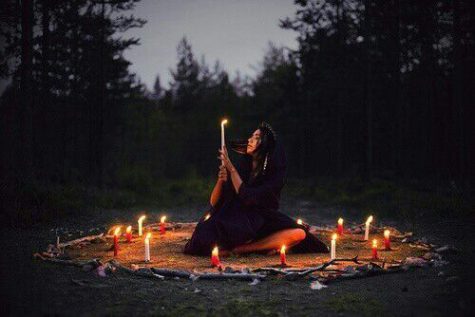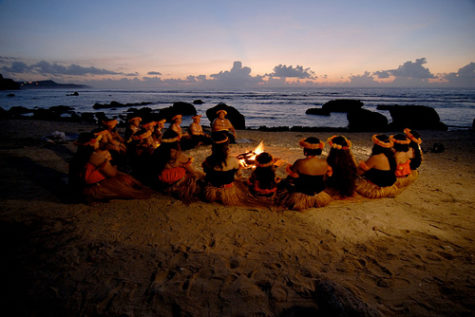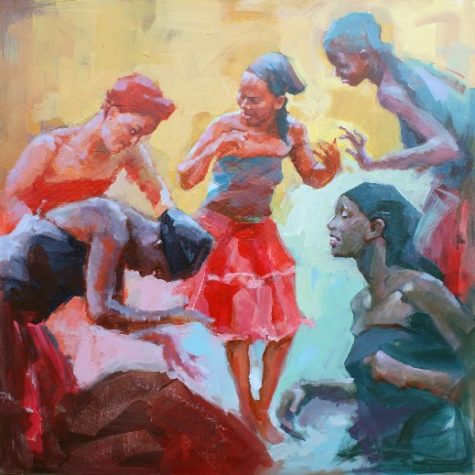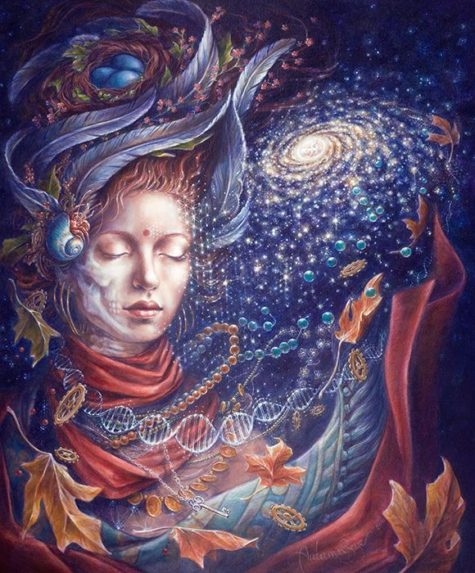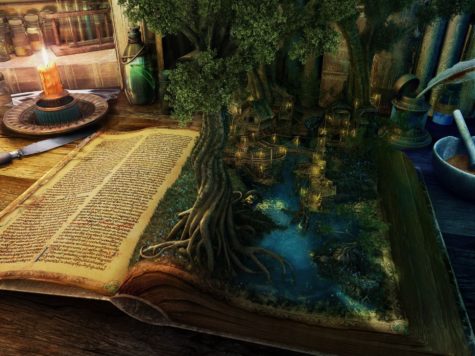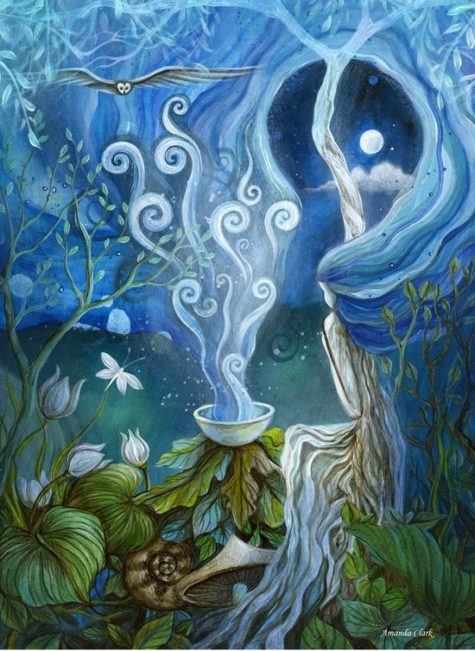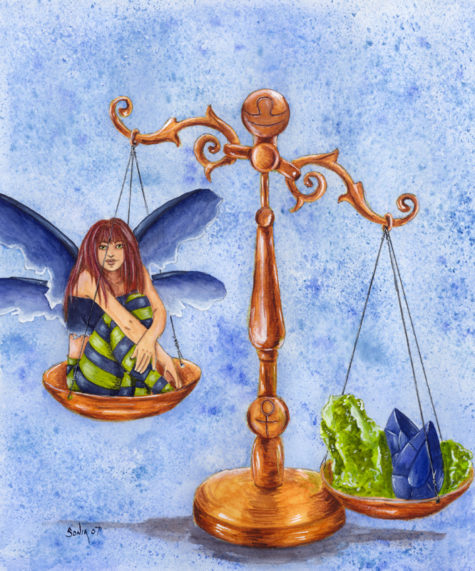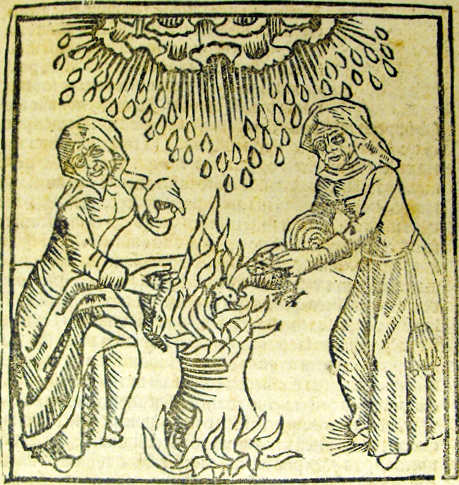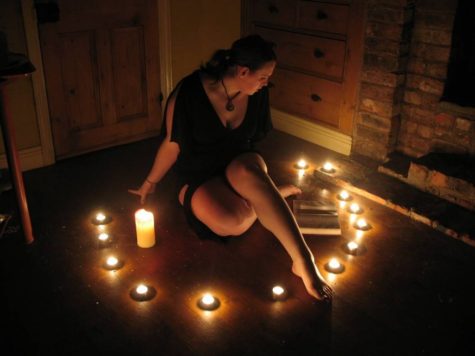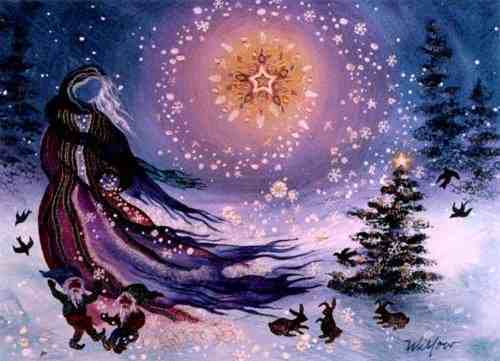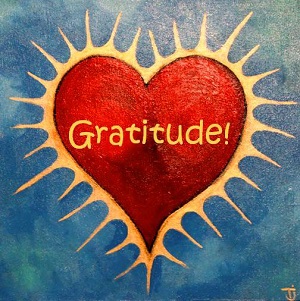Basic Concepts
They say that the longest journey begins with a single step. So, too, the exploration of Magickal studies begins with a single step. Though the first step in a physical journey is often self-evident, the First Step on a Magickal journey is often not quite so clear. While formally organized groups often have a path of lessons to instruct newcomers, the solitary or isolated student is often left standing in perplexity on this broad plain of knowledge, wondering just where in the heck to begin. And wondering, too, if it’s “okay” to start just anywhere.
While it’s true that studies can begin in a direction that attracts you, the necessary first step must be learning to make psychic shields. There are “Things of the Dark” out there. There are any number of explanations for what these things might be– ghosts, demons, or simply uncontrolled urges of the subconscious mind. In truth, it doesn’t matter what they are. What does matter is that their effect is very real and unless they are put under your control, they will drag you over the borders of sanity into psychosis.
You are most vulnerable to them while you’re in an “open” trance or meditative state. That’s why the wise practitioner always begins by taking steps to define exactly what will be permitted through the portals of their “psychic shields”– no matter how simple the ritual. And this, in a nutshell, is what “protective magic” is about.
There are a number of ways to do this. The most common is to begin by drawing a circle (around a group or yourself) and invoking the one or more protective powers. Generally, this is done by candlelight, in front of an altar that holds certain magical objects. The circle may be further “secured” and “cleared” by using salt, salt water, rum, incense, or some other method. You may be wearing a special robe and will have taken a bath (or performed a cleansing ritual) earlier. The powers that protect you will be called on and then you will begin your ritual.
Is it psychological? Absolutely! Is there a reason why protection rituals always take this form? Positively! Let’s take a step back and see what you’re actually doing and how the process works– from a psychological standpoint– and how to use this knowledge to help you refine your circles to enhance your rituals.
Psychologists and psychics alike view the mind’s structure as a three-part entity: The ego (that which you think of as yourself), the superego (the “higher self”) and the Id (the child within). The Id is, in a sense, a computer. Like most computers, it operates on the “garbage in – garbage out” principle.
There’s an old superstition “as you name something, so will it become.” Tell yourself that you’re very unlucky and your id will obligingly give you bad days by enhancing any negatives in your environment. Tell yourself that you are clumsy, and your id-computer will obligingly arrange for you to break a leg while stepping off the sidewalk.
The bad news is that the Id can’t make a judgment as to whether or not this is a good idea. It only knows that it’s received these “instructions” and must carry them out. The good news is that you can actually program/reprogram this portion of your mind.
You begin programming this Internal Servant of yours by first drawing its attention to what you want done and then explaining what you need done in a simple and clear manner. Repeating the instructions in a chant help fix the goals for the Id– rhymed chants seem to be easier for it to process. Each time you perform the ritual and repeat the chant, the programming is strengthened. Never mind that your ego and superego understand that you’re going to program the child-like Id. It works just the same.
To direct the Id’s attention to the process, you first have to impress it. Using special tools and clothing alert it that something unusual is going on and that it must pay attention. Acquiring hard-to-obtain items, drawing symbols, performing a symbolic sacrifice (donating money, say, to a good cause) are all ways of reinforcing the Id’s impression that this ceremony is very special and that the result will be very powerful. Organized, meaningful symbols, speak to your subconscious mind in ways it understands, reinforcing the goals you have set.
Drawing the circle itself establishes boundaries within your environment (“The rest of the world can do what it likes Out There. All within this circle is in MY control!”). Purifying the circle and consecrating it (sprinkling water which has been blessed and salt added) further enforce your territory, defining the borders where you are “safe”. Nothing can enter this area except what you invite inside. You further tighten these borders by calling on certain powers.
You can call on any powers you like. Some use traditional Christian images. Others call up deities from the religion they are most comfortable with. And many people use the thought/image of a beam of light that represents either God/Goddess (whichever one they like) OR The power of light and life and goodness in the Universe.
The number of powers called as guardians varies. You may choose to invoke one powerful being to protect your circle. Or you might call on the Universal Being/Light AND four guardians (one for each quarter of the compass). A third approach is to use a guardian for the four quarters of the compass and no higher being. There is no “absolutely correct” system; the correct system is the one that YOU are comfortable with.
Take time to choose the guardians of your circle carefully. You should select guardians (gods or animals or some form of life) which have a deeper meaning to you and whose qualities are in harmony with your goals. For the new student, it’s best to have all your Powers and Guardians from the same belief system/religion/mythic universe so that the symbols will be consistent and not confuse the Id.
You CAN use people– saints, movie actors, figures from favorite books as guardians. DO, however, pick someone who’s dead or non-existent. The dead can’t argue with your interpretation of them, whereas the living may be highly offended to be approached as gods/ guardians).
As your studies continue, you will find that your totems or guardians change. This is to be expected; as you explore new realms in your studies, you may find you need guardians who deal with very specific areas to strengthen and guide you in these new fields.
But don’t make the mistake of assuming that you’ll become so powerful that you will never need the protection of the psychic shielding circle in some form. And don’t assume that you will not need a circle for “positive” magick such as healing. Open is open– and open is vulnerable. And circles strengthen and protect you by defining what psychological influences will be allowed to work with you.
NOTE: It is equally important to close your circle when you are complete. This can be accomplished in a variety of ways. Key elements are a statement of intent, for example: “The circle is open” and the releasing of the energy contained within the circle either by sweeping the perimeter, retrieving objects, or whatever feels appropriate.
Author: Mel White
Group Chants are one of the most effective (and fun!) ways of raising energy, especially when combined with dancing, stylized movement, gestures, and swaying. Some of the most popular chants are those taken from Amerindian sources, such as:
I am the Circle,
I am Healing you,
You are the Circle
You are healing me,
Unite Us
Be One
Unite Us
Be as One.
We are at one
With the Infinite Sun
Forever, Forever, Forever
Such chants as these express and reinforce a sense of belonging, both between immediate group members, and with the wider world or universe. Chants tend to build up slowly, and pick up speed as people feel the growing rhythm and pulse of the words and beat, which “carries” people along – it is easy to get so caught up in the chant that you begin to enter a trance state – but don’t just take my word for it – try it out!
The Darksome Night and Shining Moon chant of Wicca is another good example of a group chant – especially when each line is chanted by a different group member. The words of the chant serve to resume the central concepts of Wicca – the four elemental directions, the magical weapons, and the complementary natures of Goddess and God, Darkness and Light.
From: The Magical Use of Voice
Why does singing and chanting have such a powerful effect on us? Repetitive or boring tasks are easier to perform if there is a tune in the background, or if someone starts to sing.
I remember with particular fondness the “work songs” which were evolved when I spent a few months picking oranges and grapefruit in Israel, and they certainly livened up what was a boring and strenuous task. Songs and chants establish rhythms, which not only distract from the boredom of a task, but also seem to add energy and help “carry” each person along. Group spirit and enthusiasm is raised.
One of the key factors seems to be rhythm. rhythms carry our consciousness along, from heartbeats, to cycles of breathing, sleeping, night-day and the passage of seasons. rhythms promote associated body movements and adjustments, and act as a signal to begin movement without conscious effort, so that less energy is expended when you begin; for example, it has been shown that soldiers can march further, and in better form, with less fatigue, when accompanied by a marching band.
The feeling of being “carried” comes from the structure that rhythm gives to our time-sense, and the pattern gives a sense of continuance. It becomes a motor attitude, and one’s attention is freed (if this is desired). rhythms also become “mirrored” by our brain activity, and they have powerful physiological effects on us. Music Therapists have found that people suffering from Aphasia or Huntingdon’s Chorea (both neurological disorders which impair speech) can carry a tune, and group singing is a common element in therapeutic voice training.
Rhythms are everywhere around us, and group chants and songs reflect this fact and bring us towards an enhanced sense of participation in the world.
Just for the purposes of discussion, I want to distinguish between ‘ordinary’ speaking and ‘sacred’ speech. Sacred speech, in this context, refers to those occasions when we are using speech (probably combined with other modes of display) to bring about a magical change – such as in inducing group trance, communing with spirits, being a horse, raising energy, and so on.
At these times, the way in which we deliver speech is different from our usual habits of talking in that there may be an enhanced deliberateness in our enunciation, or greater care taken in projecting the subtle nuances of emotion – awe, ecstasy, gentleness or martial ardour.
Whether our words well up, unbidden, from the Deep Mind, or have been carefully linked together in prolonged brainstorming sessions, it is highly likely that we will try and find a certain distinct rhythm around which to frame our words.
The Deep Mind often speaks to us in verse. Cross-cultural studies of the vocal patterns of people in the throes of possession show a striking similarity, that of a rising and falling intonation at the end of each phrase, with each phrase punctuated by a pause or groan. This pattern emerges regardless of native language and cultural background.
The English version of this rhythm is known as Iambic Pentameter. You can hear it also in the frenzied oratorical deliveries of evangelical preachers and in the apparently meaningless gush of words and phrases from those who have been seized by the ‘Holy Spirit’. It wells forth from the Deep Mind as unconscious or deity-inspired poetry and communications.
People who are overshadowed by a deity during ritual often seem to stumble over their words, as though they are trying to fit their words around the rhythms of the trance. I would conjecture that the more complete the spirit-possession, the less laboured the sacred speech, as the persons self-awareness’ will be all the more completely submerged by that of the entity.
As the Deep Mind calls to us with a particular rhythm and meter, so do we attempt to call into the depths of our being by rhythmically pulsing our speech. Sound, like light, sets up rhythms in our brains, as experiments with electro-encephalographs (EEGs) have shown. These internal rhythms reflect the sounds which propel us into varying degrees of trance, whether it is the gentle, watery lapping of the Moon or the thundering frenzy of Pan.
If we are caught off-guard, and susceptible, their effect can be devastating. J.F. Hurley, in his book, “Sorcery”, describes a trance condition known in the Philippines as Lata, which is brought on by a startling sound, after which susceptible people will imitate actions that they see or words that they hear. Philippino head-hunters took advantage of this susceptibility by paralysing their victims by using sharp, piercing cries.
This sort of talent appears in many cultures and settings. Pat Crowther, writing in her book “Lid Off The Cauldron”, mentions ‘calls’ which, when used in open spaces, can draw the unwary to the caller. Forcefully projected, stattaco hissing noises, reinforced by jerking body movements, can also precipitate trance.
Peter Redgrove, in his short novel, “The God of Glass”, makes use of the syllable SATATATAT, which, when chanted, at the same time as whirling around, produces in its initiates a disassociation, which culminates in a bee-hum – the Om of ultimate being.
To some people, the idea that “Magick” is practical comes as a surprise.
It shouldn’t. The entire basis for Magick is to exercise influence over one’s environment. while Magick is also, and properly so, concerned with spiritual growth and psychological transformation, even the spiritual life must rest firmly on material foundations.
The material world and the psychic are intertwined, and it is this very fact that establishes the magickal Link: that the psychic can as easily influence the material as vice versa.
Magick can, and should, be used in one’s daily life for better living! Each of us has been given Mind and Body, and surely we are under Spiritual obligation to make full usage of these wonderful gifts. Mind and Body work together, and Magick is simply the extension of this interaction into dimensions beyond the limits normally conceived. That’s why we commonly talk of the “super-normal” in connection with domain of Magick.
The body is alive, and all Life is an expression of the Divine. There is God-power in the Body and in the Earth, just as there is in Mind and Spirit. With Love and Will, we use Mind to link these aspects of Divinity together to bring about change.
With Magick we increase the flow of Divinity in our lives and in the world around us. We add to the beauty of it all – for to work Magick we must work in harmony with the Laws of Nature and of the Psyche. Magick is the flowering of the Human Potential.
Practical Magick is concerned with the Craft of Living well and in harmony with Nature, and with the Magick of the Earth, in the things of the Earth, in the seasons and cycles and in the things we make with hand and Mind.
The ability to think seems to set us apart from other creatures. And although we are concerned with living in the physical world, we are mental beings. The fact is we are thinking all the time. We plan, we brood, we get depressed or elated — all of it is thought. But the universe is mental too, and if we could control our thinking we would see magnificent results in the everyday world.
Many systems have been developed over the ages to help us control our thoughts. A great amount of dogma too has been kicked around in an attempt to make us into better people. Magick (the occult kind, spelled with a ‘k’) is one of the oldest and most general of these systems. Magick is the study and application of psychic forces. It uses mental training, concentration, and a system of symbols to program the mind. The purpose of magick is to alter the self and the environment according to the will.
Most of the magick we see today comes to us from ancient Egypt and Chaldea. The Chinese, Hindus, and Tibetans developed their own unique types of magick. Western magick was locked up by the Egyptian priests for thousands of years and then suppressed by the rise of Christianity. It was not until medieval Europe that magical knowledge was rediscovered by the alchemists and Cabalists. Only during the past hundred years or so has western culture been open minded enough to permit widespread investigation of the subject. Only since the start of the twentieth century has science shown much interest in it at all.
Author: Phil Hansford
Magick encompasses many things – science and art, philosophy and metaphysics, psychology and comparative religion. Magick is an adventure at the borderlands of the unknown. It can fit the pieces of the puzzle of life into a meaningful whole.
- Magick is fun and interesting.
Use magick to help raise consciousness without drugs. Gain new experiences. Fantasy can come alive through magick. Psychic phenomena can be controlled and be fun and helpful.
- Magick is beneficial.
It can help you to have excellent health, and bring you good luck. With magick, life runs smoothly; life is good. Magick can also be used for personality improvement, to control bad habits and to develop new motivations.
- Magick is powerful.
Never underestimate the tremendous power of magick. Use magick to alter events and to achieve your goals. Exert an influence over people and phenomena. But remember, power for its own sake is self defeating. The power which magick can give you should not be your primary reason for studying it.
Author: Phil Hansford
Consider the herbalist’s scales: things are carefully weighed out to achieve a desired balance. Magic plays with balance too. Sometimes the desire is for all forces to be equal and harmonious. At other times goals are accomplished by deliberately, consciously tipping the scales to provide the required effect.
Left and Right:
Once upon a time, not too long ago, the concept of Dualism associated the direction right with God, high, male, and all those good things. Thus children were forced to use their right hands, the dexterous hand, whether that was their dominant hand or not. Children who were naturally left-handed (the sinister hand) literally had it beaten out of them until they were dexterous too. Consider various phrases: in the right, Mr. Right, the left-hand path, a left-handed compliment.
Connections between genders and these directions, however, predate Dualism and Christianity. They exist in completely unrelated cultures, including some that were isolated for a very long time. Hawaiian magic, for instance, associates left with female, right with male as surely as the Chinese and many Asian, African and European traditions. Frequently offerings to female deities are made with the left hand (by both men and women) while offerings to males are made with the right (by both men and women). Feng shui suggests that it’s beneficial for women to sleep on the left side of a common bed, while a man should sleep on the right. (Although spells intended to reverse the power dynamic within a relationship may suggest those sides be switched.)
Sometimes spells direct that an action be performed with either your left or right hand. Either one of two things is being requested.
1 – Because left is yin and yang is right, the left side of everyone’s body is yin or affiliated with “female forces” while the right side is yang and affiliated with “male forces.” Most frequently a spell’s success depends upon accessing one force or emphasizing one quality over the other.
2 – Sometimes the spell’s success depends upon not using your dominant hand. Because until recently everyone was forced to be right-handed, many older spell books will specify casting a spell with your left hand, because it’s assumed that everyone is right-handed. This is, obviously, no longer the case.
In newer spell books, where the importance lies in not using your dominant hand, this is specified in spell-directions. Left-handed people will be directed to use their right hands. Where no such direction is given, if the only stipulation is to use your left hand, then this applies to everyone across the board.
Article from: Encyclopedia of 5,000 Spells
The medieval demonographer, Martin Delrio, in his Disquisitionum Magicarum Libri Sex, gives this definition:
“An art or skill that, by means of a not supernatural force, produces certain strange and unusual phenomena whose rationale eludes common sense…”
What follows is an interesting (but very dry and scholarly) essay on magic by Harry Wedeck. I did have to pull out my dictionary a couple of times – he does love those big words – but it made me think, gave me a wider perspective, and because of this, I think it deserves a read. So here it is:
Magic is protean. It has multiple names, numberless forms. It is thaumaturgy (the working of miracles) and goety (invocation of spirits). It is witchcraft and it is religion. It is superstition and legend, tested by its potency, its primary effects on the individual, sometimes on the community, and not rarely on large ethnic groups. It enters into private domestic life, and pervades the tribal community. On occasion, it dominates, in its malignant impact, an entire nation, upheaving governments, creating devastation and civic chaos.
It pierces the very basic roots of existence, and sometimes forms itself into a religious cult, capable of overthrowing an established religious system. Impalpable sometimes, at all times secretive and cryptically esoteric, its powers rest in the grip of small dedicated hieratic groups; or in the control of an arch adept; or even, as in ancient Italy, as in the antique Chinese dynasties, in the supreme ruler himself, who is both first citizen and thaumaturgic (miracle working) priest.
Two aspects of witchcraft manifest themselves: White Magic, and the Black Art. Certain demonographers, and magicians as well, have assigned to White Magic an ethical motive: to benefit both the living and the dead. Black Magic, on the other hand, is completely malefic in its operations and its intent. It performs maleficently against its victims, against enemies, and contrary to the normal, commonly accepted view of the orderly sequence of cosmic rhythms in harmony with beneficent mankind.
Fundamentally, magic is the imposition of the human will on the phenomena of nature: and that imposition extends, in the actual practice of Black magic, into a conflict between two forces, one beneficent, and other malefic: constantly at war, over the entire cosmos. That was the primary concept of the ancient cult of the Manichean’s, of the equally mystic cult of Zoroaster.
Witchcraft in its necromantic (communication with the dead), thaumaturgic (working of miracles), and apotropaic (warding off evil) diversity, has invariably been a significant phenomenon of all cultures, at whatever level of development.
It has never been a mere academic diversion. On the country, it has been an integral element, coloring and molding religious, political, and social situations and attitudes. And its impact, in these three directions, has been impressively pronounced in a very realistic sense.
In early ages there was no demarcation between religion and magic. Religion was largely magic, for all religion was directed toward communication with diving agencies and toward a degree of cooperation of these deities for the advantage of man. The pagan rites, the mystic ceremonials of the priestly castes – Egyptian and Assyrian, Hittite and Babylonian – the Eleusinian Mysteries, the Dionysian performances, the cult of Mithra, the festal glorifications involving dedications and sacrifices, paeans (songs) and supplications and invocations – were associated with thaumaturgic arcana (mysteries).
The flow of folk thoughts and tendencies was all directed toward a projection of the self beyond the material, normally observable limitations of the human frame and the human spirit. Ancient witchcraft and wizardry in all their multiple permutations and impacts, like their modern counterparts, constituted virtually an ultimate faith.
Magic was (and still is) a stubborn credo that would not be refused. It was belief without reservation. Whether belief in beneficent principles or in actively malefic potency’s, is another matter. But it was credence that equated man with these agencies, unseen, yet real, that governed the cosmos. It was, in short, man’s attempt toward divinity.
And through the long and perplexed centuries, although magic assumed crudities and accretions of bestiality and demoniac contacts, it was basically the spiritual means, though perverted, made manifest toward this consummation. Magic was the epiphany of man’s ultimate faculty.
It may be said that ritual is the very heart of magic. For it is through ritual that we achieve our magical results. Ritual is a magical procedure or ceremony we perform in order to change the environment. Usually we think of ritual as bearing on active magick, although certainly, it can also affect passive magick.
Most often the change achieved is subjective (it may be subtle) and in the physical world. Outsiders may put them down to coincidence, but the effects are very real. Magical goals for a ritual should not be taken lightly.
The successful practice of magick depends upon strong belief. The simplest ritual of them all must be belief itself. If you can believe in your desired results strongly enough, that act is a magical ritual which will achieve your results. Even a very complex ritual is no more effective than strong belief.
By: Phil Hansford
- Invocation to the Archangels as a Group by shirleytwofeathers - No Comment
- Invocation to Lord Melchizedek by shirleytwofeathers - No Comment
- Connecting with Fairies by shirleytwofeathers - No Comment
- To Enhance Clairvoyance by shirleytwofeathers - No Comment
- For Release of Addictions and Cravings by shirleytwofeathers - No Comment
- Using the Psalms for Solving Problems by shirleytwofeathers - 148 Comments
- Spiritual Assistance Spell by shirleytwofeathers - 35 Comments
- 62 Spells To Defeat Your Enemies by shirleytwofeathers - 27 Comments
- Once In A Blue Moon Spell by shirleytwofeathers - 24 Comments
- Spell To Find A Lost Pet by shirleytwofeathers - 12 Comments
Mauro: Ritual To Become A Werewolf
Mauro: Becoming A Werewolf Ritual
Janet Silva: Wheel of Fortune Change Your Luck Spell
Linda: Sweet Thoughts Bottle Spell
AnnD: Chant For Guidance
